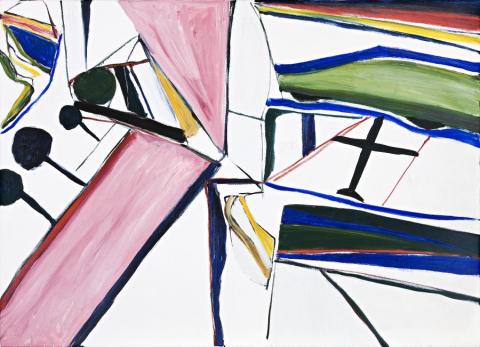FIUMICINO, 1979
KEN WHISSON
oil on canvas
79.0 x 109.0 cm
signed and inscribed verso: Ken Whisson / FIUMICINO / Jan or Feb 1979
Watters Gallery, Sydney
Private collection, Sydney
Spending his formative years as an artist in Melbourne at the periphery of the modernist circle at Heide, Ken Whisson forged a singular and driven artistic vision that he has maintained over 60 years of practice.
Fiumicino, 1979 is a unique example of Whisson's work from the late 1970s period. Transport is a particular leitmotiv running through Whisson's work from its very beginning and he depicts the world around him as if something has been snatched from a dream or memory. Recognisable elements drift in and out - a tree, the silhouette of a plane, a rushing car - and are then pinned to the surface of the work in his typical expressive, robust yet conversely delicate, painting style.
At the time this work was painted the artist had only recently moved and settled in the Italian city of Perugia where his work underwent a major technical shift as he abandoned board and moved to canvas.
This pivotal change was, to begin with, mainly practical - canvas could be much more easily shipped back to his galleries in Australia - but it irrevocably changed the work. Gone was the hard surface of board upon which forms seemed to sit quite solidly, to having to deal with a material that did not offer the same resistance. Now the space between objects and motifs became as important as the figures themselves and the colours and form started to float and take off - as typified by his series of paintings, collectively known as the Flag paintings, roughly contemporaneous with the Fiumicino.
Fiumicino, rather typically of the period, plays with space and depicts a landscape at various viewpoints. Travel provides not just new opportunities for the landscape to be revealed in cultural ways, but in a distinctly physical sense. The aerial view is a device the artist has used since then to great effect - it allows him to fold the landscape up and disperse it across the picture plane, allowing the landscape to be seen as an abstraction as well as a specific space as implied by the title.
GLENN BARKLEY
